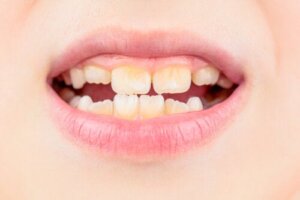Amelogenesis Imperfecta: What Is It and How Is it Treated?


Written and verified by the dentist Vanesa Evangelina Buffa
Dental enamel is the hard outermost tissue that covers and protects our teeth. However, there are some rare conditions that can affect this structure. Amelogenesis imperfecta is one of them and we will talk about it in this article.
Enamel is the hardest tissue in the body, which covers and protects the visible portion of the teeth. It’s formed by calcium phosphate, in the form of hydroxyapatite crystals. It’s also what gives our teeth their characteristic whitish appearance.
However, during the formation of the teeth, anomalies can occur that affect the correct development of the tissues. In amelogenesis imperfecta, the enamel fails to form normally. Why does this happen? Find out!
What is amelogenesis imperfecta?
Amelogenesis imperfecta is a genetic condition that interferes with the normal development of tooth enamel. This pathology can occur in both milk teeth and permanent teeth.
It’s a rare condition. Data on its prevalence differ according to the country, although in global terms it’s estimated to occur in 1 in 200 people.
The origin of this dental disease lies in genetic mutations that are transmitted from parents to children. However, there can also be alterations in the genetic material without a family history.
Several genes are involved in the formation of enamel – a process known as “amelogenesis”. The origin of the disorder may be due to mutations in any of these pieces of genetic material.
As the disease develops, the teeth undergo changes in appearance and structure. In particular, they’re smaller, brittle, and often stained. They’re also more likely to become sensitive, wear, decay, or fall out.

Find out more: LED Teeth Whitening: Advantages, Disadvantages, and Care
Types of amelogenesis imperfecta
Changes in the tooth enamel are the main characteristic of amelogenesis imperfecta. Even sdifferent clinical forms of the disease differfer in their manifestations. This depends largely on the gene affected and the process of enamel formation it’s involved in.
This means that the symptoms of the disease vary according to the time at which the alteration occurs. In some cases, different types can coexist in the same patient.
According to the Center for Genetic Information and Rare Diseases, four main variants have been determined. These, in turn, are subdivided into 17 or 18 subtypes, according to the genetic mutations that give rise to them.
Type I or hypoplastic
The changes occur at the beginning. The cells that should specialize to take care of enamel formation fail to form into ameloblasts. The result is the presence of a very thin outer tooth layer.
The teeth have a rough surface with linear depressions and are usually brown in color. In addition, it’s common for the teeth to be smaller and poorly implanted.
Type II or hypomaturation
The defect occurs at the end of the enamel formation process. The calcification of the tissue is incomplete and defective. The enamel of these teeth usually has a modified consistency and isn’t as hard as usual.
Thus, it fails to fulfill its protective function and it’s common for teeth to break and damage easily. In the meantime, the coloration is usually yellow-brown and the surface is smooth. Some cases have a mottled appearance or with vertical striations.
When taking radiographic images, there isn’t such an evident contrast between enamel and dentin, as occurs in healthy teeth. It’s common for patients with this type of amelogenesis imperfecta to have tooth sensitivity and associated occlusion problems, such as open bite.
Type III or hypocalcified
In this type of amelogenesis imperfecta, the problem occurs during the calcification phase of the organic matrix. In this case, the amount and thickness of the enamel is normal, but the mineralization is lower.
The teeth are yellow-brown in color and their consistency is soft. As in type II, they are very fragile, are often chipped, and break easily. In radiographic images, the enamel is less radiopaque than usual.
Due to the poor quality of the enamel, these teeth easily suffer tissue loss or wear due to external factors. This happens early on, exposes the underlying dentin, and causes sensitivity problems.
This type of amelogenesis imperfecta is also associated with some occlusion problems.
Type IV or hypomaturation-hypoplastic
In this case, the characteristics of amelogenesis imperfecta type I and II are combined. It often occurs together with taurodontism, an anomaly in the shape and size of the pulp chamber of the teeth.
The enamel layer is thin and smooth, and the color is white, brown, or yellowish with spots. A differential diagnosis should be made with dental fluorosis, as the appearance is similar.
Complications of amelogenesis imperfecta
Insufficient or poor-quality enamel means that teeth with amelogenesis imperfecta don’t have sufficient protection. Thus, common practices such as eating, chewing, or brushing the teeth can lead to wear and loss of tooth tissue.
The alteration leads to exposure of the underlying dentin. This means that the person suffers tooth sensitivity on contact with cold, hot, or sweet substances, and also when biting. In some cases, the pain can become quite intense and chronic.
It also increases susceptibility to the action of bacteria and their acids. Therefore, the appearance of cavities is quite common. It’s also common for teeth to break or fracture easily, even in common activities such as chewing.
Among other things, this pathology can affect the tissues surrounding the teeth. The gums, root cementum, periodontal ligament, and alveolar bone can all be affected.
And, because defective enamel affects dental esthetics, problems with self-esteem and confidence are common. For some, it’s even a cause for rejection or ridicule.
Discover more here: The Causes of Stained Teeth
Diagnosis and treatment
Changes in the appearance of the teeth mean that the diagnosis of amelogenesis imperfecta is made as soon as the teeth appear in the mouth. This will be in infants or older children, depending on whether the affected elements are deciduous or permanent.
Oral examination and radiographic imaging are usually sufficient to arrive at a diagnosis. Even so, family history and complementary and genetic studies can all help to confirm the disorder.
Treatment
Treatment will depend on the type of amelogenesis imperfecta diagnosed and the age of the patient. Therapy will change and be renewed as the child grows older, in order to accompany their development and new needs.
In some cases, sealings and direct resin fillings may be helpful. However, restorations with crowns that cover and protect the entire tooth are the most commonly used measure.
These procedures not only avoid the associated complications, but also ensure that the elements acquire a similar color, shape, and size to normal ones. In other words, it brings esthetics and functionality to the mouth.
When children are older, it’s important to evaluate the need for orthodontic or surgical treatments, because, as we mentioned, malocclusions are frequent in these patients and their timely correction will avoid future problems.
Preventive procedures are also part of the care of patients with amelogenesis imperfecta. These are some of the measures that help to take care of this type of dentition:
- Adequate oral hygiene
- Healthy diet, low in sugars and acidic substances
- Topical application of fluoride
- Placement of sealants
- Chlorhexidine rinses
- The use of special kinds of toothpaste for tooth sensitivity
In more severe cases, extraction of teeth with poor prognosis and subsequent prosthetic rehabilitation will be recommended.

Looking after children with amelogenesis imperfecta
Amelogenesis imperfecta is a rare oral disorder. However, for those who suffer from it, this condition alters the aesthetics and functionality of their teeth. In addition, it predisposes them to suffer annoying complications such as sensitivity, fractures, and cavities.
Taking children to the pediatric dentist early is a key action to detect and address this problem in time. The professional attends to the child with the appropriate therapeutic measures for their age, which improves their quality of life.
Home care is also very important. Taking care to maintain proper oral hygiene and a healthy diet low in sugars and acidic foods helps prevent complications associated with these unprotected teeth.
All cited sources were thoroughly reviewed by our team to ensure their quality, reliability, currency, and validity. The bibliography of this article was considered reliable and of academic or scientific accuracy.
- Gadhia, K., McDonald, S., Arkutu, N., & Malik, K. (2012). Amelogenesis imperfecta: an introduction. British dental journal, 212(8), 377-379.
- Villar Basaure, F. J., Zapata González, G. M., & Valdés, P. (2021). Amelogénesis imperfecta y su asociación a manifestaciones sistémicas. Una revisión narrativa.
- Hurtado-Villa, P., Tobar-Tosse, F., Osorio, J., & Moreno, F. (2018). Amelogenesis imperfecta in a family. Revista Cubana de Estomatología, 55(2), 1-10.
- Varela, M., Botella, J. M., García-Camba, J. M., & García-Hoyos, F. (2008). Amelogenesis imperfecta: revisión. Cient. dent.(Ed. impr.), 239-246.
- Hurtado, P. M., Tobar Tosse, F., Osorio, J., Orozco, L., & Moreno, F. (2015). Amelogénesis imperfecta: Revisión de la literatura.
- Rodriguez-Chávez, S., Munayco-Pantoja, E. R., Ruiz-Yasuda, C., Torres-Ramos, G., Blanco-Victorio, D., & Chein-Villacampa, S. (2019). Tratamiento conservador de un adolescente con amelogénesis imperfecta. Revista clínica de periodoncia, implantología y rehabilitación oral, 12(3), 127-130.
- López Jordi, M. D. C., & Szwarc, E. (2019). Diagnóstico y tratamiento integral en pacientes con Amelogénesis Imperfecta: reporte de un caso. Rev. odontopediatr. latinoam, 54-65.
- Simancas Escorcia, V., Natera, A., & Acosta de Camargo, M. G. (2019). Amelogénesis imperfecta en pacientes pediátricos: serie de casos. Revista Odontológica Mexicana, 23(2).
- Strauch, S., & Hahnel, S. (2018). Restorative treatment in patients with amelogenesis imperfecta: a review. Journal of Prosthodontics, 27(7), 618-623.
This text is provided for informational purposes only and does not replace consultation with a professional. If in doubt, consult your specialist.








